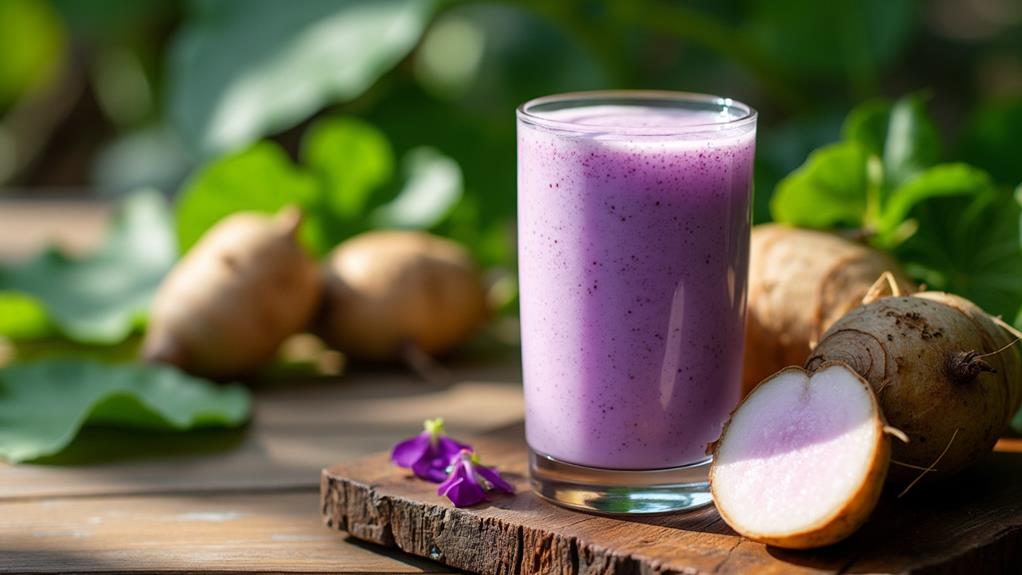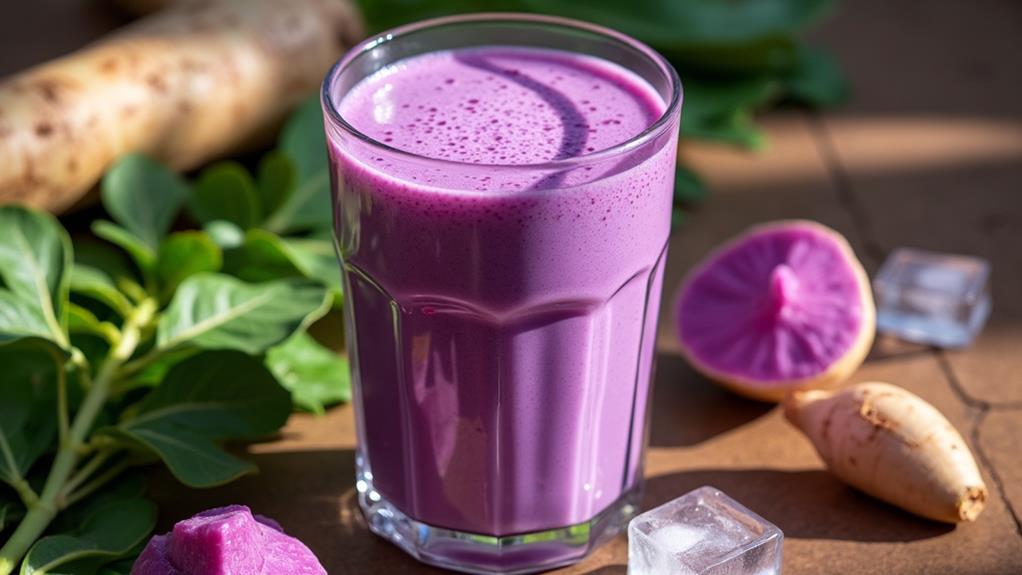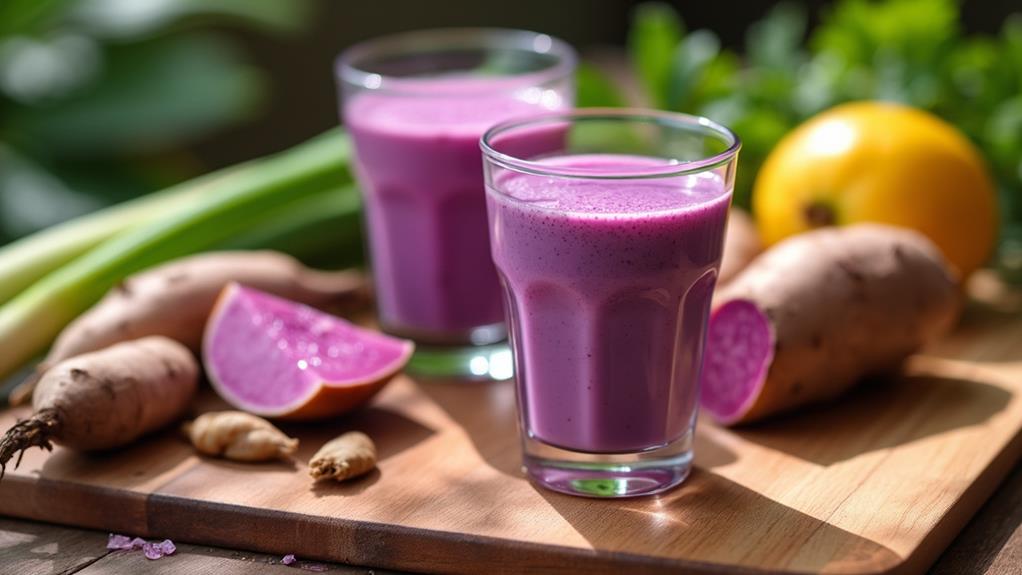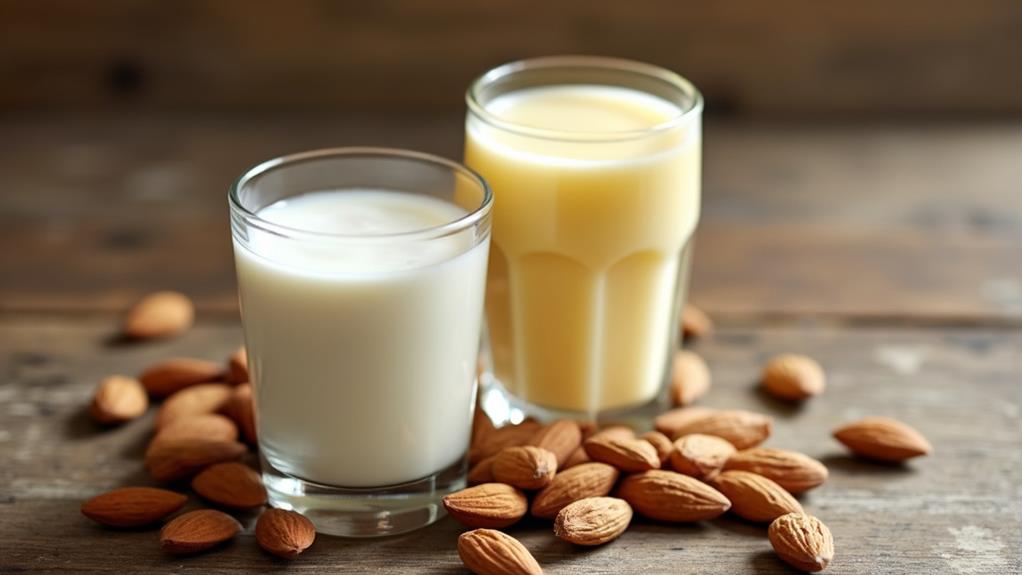Taro Root Juice: Sweet and Starchy, A Perfect Energy Boost

Taro root juice is your perfect sweet and starchy energy enhancer. With 187 calories per cup primarily from carbohydrates, it provides a natural pick-me-up. This juice not only aids digestion thanks to its 6.7g fiber but also strengthens metabolism with 30% of your daily manganese needs. Loaded with antioxidants like vitamin E and C, taro juice supports your immune system and reduces oxidative stress. Enjoy its versatility in smoothies, desserts, and even cocktails. Rich in resistant starch, it acts as a prebiotic, promoting gut health. Uncover how this nutrient-dense beverage can improve your energy and well-being further.
Nutritional Profile of Taro Root
Have you ever wondered what makes taro root a powerhouse of nutrients? This starchy tuber packs a remarkable nutritional profile that can complement your diet. A single cup of cooked taro root provides 187 calories, mostly from carbohydrates, making it an energy-dense food ideal for those needing a quick energy enhancement. Despite its richness in carbs, taro root is low in fat, containing only 0.1g per serving, making it a great choice for low-fat dietary plans.
Taro root stands out with its impressive dietary fiber content. With 6.7g of fiber per cup, it not only aids in digestive health but also helps you feel fuller for longer, promoting satiety. You'll also benefit from its array of fundamental nutrients. It delivers 30% of the Daily Value (DV) for manganese, significant for metabolism and bone health. Moreover, taro root provides 22% DV of vitamin B6, supporting brain function, and 19% DV of vitamin E, which acts as an antioxidant.
Furthermore, taro root is a good source of potassium, contributing 18% DV. This mineral plays an important role in regulating blood pressure and maintaining heart health.
Health Benefits of Taro Juice
Many people are uncovering the impressive health benefits of taro juice, a nutrient-rich beverage packed with significant vitamins and minerals. Taro root juice is an excellent source of vitamin C, vitamin E, and potassium, all of which bolster your immune function and support comprehensive well-being. These fundamental nutrients help keep your body's defenses strong, ensuring you stay healthy and lively.
The antioxidants in taro root juice play a key role in combating free radical damage, which can lead to chronic diseases. By including this beverage in your diet, you can promote cellular health and potentially reduce the risk of such conditions. Moreover, the high fiber content in taro root juice aids digestion and supports gut health by nurturing beneficial gut bacteria.
For those focused on weight management, taro root juice can be a valuable ally. Its ability to improve satiety helps control hunger, while also assisting in blood sugar regulation. This makes it an ideal choice for maintaining balanced energy levels throughout the day. As a low-fat, cholesterol-free energy source, taro root juice serves as a nutritious beverage option for anyone seeking a healthier lifestyle. Enjoy its sweet, starchy goodness and reap these health benefits!
Resistant Starch in Taro

A notable feature of taro root is its rich content of resistant starch, making up about 12% of the starch in cooked taro. This type of starch acts as a prebiotic, fueling healthy gut bacteria and enhancing your digestive health. By supporting the production of short-chain fatty acids, resistant starch lowers colon cancer risks and contributes to comprehensive digestive wellness.
Incorporating taro, a starchy root vegetable, into your diet offers numerous health benefits. One key advantage is its ability to improve insulin sensitivity. This can reduce the risk of developing type 2 diabetes and help regulate blood sugar levels. When you consume foods high in resistant starch like taro, you're likely to feel fuller longer. This feeling of fullness supports weight management by reducing complete caloric intake and helping you manage your diet more effectively.
Moreover, resistant starch in taro bolsters your metabolic health, making it a valuable enhancement to a balanced diet. As you enjoy taro root juice, you're not just getting an energy lift; you're also benefiting from its unique nutritional properties. So, savor this sweet and starchy drink while supporting your health in multiple ways.
Antioxidant Properties
While the resistant starch in taro root improves your digestive and metabolic health, the juice of this remarkable root also shines with its antioxidant properties. Packed with antioxidants like vitamin C and polyphenols, taro root juice is a powerful ally in combating oxidative stress. This stress results from harmful free radicals, which can wreak havoc on your cells. By neutralizing these free radicals, the antioxidants in taro root juice contribute to cellular health and longevity, potentially reducing the risk of cancer and chronic diseases.
One of the standout polyphenols in taro root is quercetin. Known for its strong antioxidant capabilities, quercetin plays an essential role in promoting heart health. It helps lower the risk of chronic diseases by supporting healthy blood vessels and reducing inflammation. This reduction in inflammation also translates to benefits for your skin health. Regular consumption of taro root juice can protect your skin cells from damage caused by environmental factors, promoting a more youthful appearance.
Incorporating taro root juice into your diet means you're actively supporting your body's natural defense mechanisms, paving the way for better general health and well-being. Enjoy the sweet, starchy taste while nurturing your wellness.
Culinary Uses of Taro Juice

Taro root juice isn't just a health powerhouse; it's also a flexible improvement to your culinary repertoire. With its sweet and starchy flavor profile, this rejuvenating juice can transform a wide range of dishes. Start your day with an energy lift by blending taro root juice into smoothies. Its creamy texture and rich vitamins and minerals augment the nutritional value, making your morning drink both delicious and stimulating.
Incorporate taro root juice into desserts to add a subtle sweetness and lively hue. Regardless of it being puddings or cakes, the juice enriches these treats, making them not only flavorful but also visually appealing. For more adventurous culinary applications, use taro root juice in savory dishes. Its unique taste can raise sauces and soups, adding depth and a hint of sweetness that complements diverse ingredients.
Taro root juice also shines in cocktails, where its distinct flavor and color harmonize with spirits and mixers. By exploring the numerous uses of taro root juice, you can create dishes and beverages that are as nutritious as they are delightful, ensuring every meal has an exciting, revitalizing twist.
Comparing Taro and Other Roots
When exploring the nutritional benefits of root vegetables, you'll find taro root stands out in several ways. It's not just about being starchy and rich in carbohydrates; taro root offers a significant fiber content, with 6.7g per cup, outpacing many roots like potatoes. This high fiber content supports your digestive health, promoting feelings of fullness and aiding in regular digestion.
Taro root also provides a unique combination of resistant starch and fiber, which is beneficial for gut health. This resistant starch helps with blood sugar regulation, making it an excellent choice if you're looking for a steady energy enhancement without sudden spikes.
While sweet potatoes are known for their beta-carotene, taro root shines with its antioxidant properties, thanks to its higher vitamin E content. These antioxidants may help reduce the risk of chronic diseases. Furthermore, taro root contains more vitamin B6 compared to carrots, which is vital for hemoglobin synthesis and general metabolic processes.
Moreover, taro surpasses roots like cassava in manganese content, supporting metabolism and bone health. With these nutritional benefits, taro root is a versatile and powerful supplement to your diet.
Cultural Significance of Taro

With its impressive nutritional profile established, it's clear why taro root holds a special place not only in diets but also in cultural traditions across the globe. Taro is a staple food in many Asian and Pacific Island cultures, appearing in traditional dishes that highlight its culinary importance. In Hawaii, taro's cultural significance is profound; it's considered sacred and vital in making poi, a dish symbolizing the deep connection between land and people. This sacredness underscores taro's role beyond nutrition, anchoring it firmly in cultural heritage.
Taro's historical domestication over 2,000 years ago in Southeast Asia marks its extensive cultural path, spreading its influence across the Pacific Islands. Its cultivation supports sustainable farming practices, thriving in wet conditions and promoting biodiversity. This adaptability guarantees taro remains an ecological asset, crucial in maintaining ecosystem health. Besides its culinary uses, taro leaves enrich the nutritional profile of dishes and reflect its significance in traditional medicine, where they're valued for their versatility and health benefits.
As you investigate taro's cultural significance, consider its role not just as food, but as a symbol of tradition, sustainability, and historical continuity.




